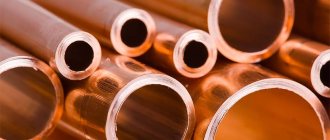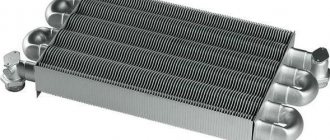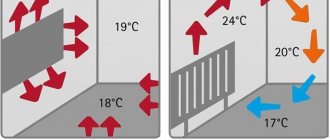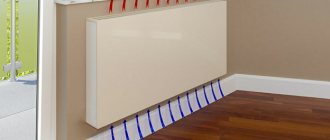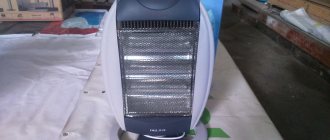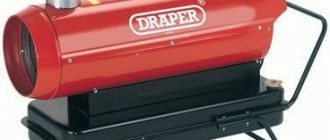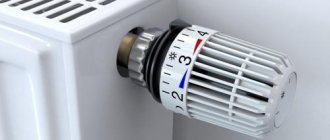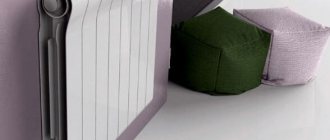Heating
Author Alexey Ozhogin
Date
Sep 13, 2016
0
1 975
Share
The popularity of using heating devices powered by electricity in heating is due to ease of use. Electrical appliances are safer than gas and environmentally cleaner than solid fuel systems. Their disadvantage is the high cost of consumed resources. The problem will be solved by installing a vortex induction heater. The device features high performance with minimal power consumption. Anyone who is comfortable with a soldering iron can make an induction heater with their own hands.
- LiveJournal
- Blogger
A vortex induction heater is an electromagnetic device for heating a heat exchange device in the form of a pipe
- Operating principle of equipment VIN 7, 10, 30, 40
- Advantages and disadvantages of vortex induction heaters
- Induction generator in a heating system
- How to make an induction heater with your own hands according to the scheme: the cost of materials is not high
- Security measures
What is an induction boiler?
Induction heating systems began to be used in the 80s of the last century in industrial enterprises.
Household appliances appeared only in the mid-nineties. Over the past decades, they have been refined and some updates have been made to their design, however, the principle of their operation remains unchanged. The name of these heating systems and devices in itself indicates that their operation is based on electromagnetic induction. The essence of the operating principle is that if an alternating current is passed through a wire of a sufficiently large diameter cross-section, wound in the form of a coil, then a powerful electromagnetic field is created around this primary winding. If there is a conductor in this field, then voltage will be induced (induced) in it. Well, if the field lines intersect a core made of an alloy with magnetic properties located in it, then a kind of short-circuited circuit is obtained. And due to the appearance of stray Foucault currents on it, very fast and strong heating of this material occurs.
The simplest diagram of the operating principle of an induction heater
This principle is widely used, for example, in the steel industry. They also found a use for it for fast and high-temperature heating of water. It is clear that the core in this case will be a pipe or other channel through which the coolant circulates.
And the most understandable example of an induction heater is a wire wound around a pipe made of a dielectric, which will insulate a magnetic core placed in its interior.
The wire coil is connected to the power supply and creates an electromagnetic field. As a result of exposure to an alternating electromagnetic field, the metal core rod will heat up, transferring heat to the coolant, which then enters the pipes and radiators of the heating circuit. Oil, water or ethylene glycol can be used as a coolant in autonomous heating systems.
Instead of a core, modern boilers use a whole labyrinth of channels and pipes for heat exchange. Their walls, made of a ferrimagnetic alloy, provide a large area of contact with water and therefore very intense heating of the coolant circulating through them
This is, of course, a very simplified explanation. In industrial induction boilers, the heat exchange ferromagnetic core can be a whole labyrinth of pipes or channels, and often, for example, in vortex heaters, the body of the device is also involved in this process.
One induction boiler of correctly selected power is capable of providing heated coolant to several circuits of an extensive heating system. Naturally, with proper placement of collectors and circulation pumps.
In heating systems of short length, the coolant, when heated, will rise upward, and the created natural pressure is usually sufficient for its natural circulation. If the heating main is quite long and branched, connected to collectors with further distribution of coolant flows along separate circuits, then one or more circulation pumps are installed in the system, since without them the required coolant movement will be impossible to achieve.
Induction generator in a heating system
For autonomous heating in a private house, you will need a transformer consisting of two short-circuited windings. Eddy currents arise inside the device, and the electromagnetic field is directed to the secondary winding. The secondary circuit acts as a base and heater for the circulating substance. A conductive substance (oil, water, antifreeze) is used as a heating fluid.
A vortex induction boiler is installed in a convenient location. Similar to traditional water heating heating units, two pipes are connected to the inductor heater. One serves to supply water to the boiler, the other ensures the coolant exits into the pipeline and further distribution to the batteries. The substance enters the pipeline naturally. As a result of different densities of cold and hot water, hydrostatic pressure is formed, which provokes a circulation.
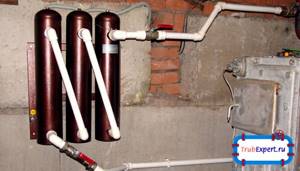
- LiveJournal
- Blogger
Advice! Despite the creation of natural circulation during the induction heating process, experts recommend the mandatory installation of a circulation pump.
An induction generator is used in heating as an air heater. Making a vortex heat generator with your own hands at home is more difficult than making an electromagnetic boiler. In addition, an inverter air heater is justified when mobile heating of large rooms is required. Five advantages of induction heat generation in a private home:
- Saving energy resources
- Silent operation
- No harmful substances
- The operating vibration of the device prevents sediment deposits on the walls of the pipeline
- Long service life
It is not difficult to create a primitive inductor with your own hands at home. This does not require a large set of tools and equipment. The induction heater circuit is simple.
Characteristics of induction boilers produced in 2015

The operating principle of boilers of the indicated brands is discussed below, and a comparison of the main performance characteristics of induction boilers produced in 2021 is given in Table 1.
Comparison table for performance characteristics of induction boilers from various manufacturers.
| Brand | Power, kWt) | Voltage (V) | Efficiency (%) | Heating area sq.m/volume cubic meter | Weight, kg) | Dimensions (mm) |
| Prof SAV-2.5 | 2,5 | 220 | 99,0 | 30/ — | 23,0 | 425*121*121 |
| Spec SAV-100 | 100,0 | 380 | 99,0 | 1300/ — | 99,90 | 1500*1000*100 |
| VIN-2.2 | 2,2 | 220 | — / 90,0 | 26,0 | 600*159 | |
| VIN-100 | 100,0 | 380 | — / 4100,0 | 342,0 | 1100*530 | |
| For VIN boilers, the dimensions column shows the height and diameter values | ||||||
| Edison-4.7 | 4,7 | 220 | 98,0 | 370*220*1035 | ||
| Edison-500 | 500,0 | 380 | 98,0 | 1579*625*1770 | ||
| Galan | ||||||
| Ochag-3 | 3,0 | 220 | — / 120,0 | 0,9 | 275*35 | |
| Geyser-9 | 9,0 | 220 | — / 340,0 | 5,0 | 360*130 | |
| Vulcan-50 | 50,0 | 380 | — / 1650,0 | 11,5 | 570*180 |
Criterias of choice
When choosing a vortex heat generator, it is important to determine the current parameters of the device that are most suitable for solving the task. These parameters include:
The parameters of some vortex heat generators are shown in the table below:
Table: characteristics of some models of vortex generators
| Installed electric motor power, kW | 55 | 75 | 90 | 110 | 160 |
| Network voltage, V | 380 | 380 | 380 | 380 | 380 |
| Heated volume up to cubic meters. | 5180 | 7063 | 8450 | 10200 | 15200 |
| Maximum coolant temperature, o C | 95 | 95 | 95 | 95 | 95 |
| Net weight, kg. | 700 | 920 | 1295 | 1350 | 1715 |
| Dimensions: | 2000 700 775 | 2000 700 775 | 2000 700 775 | 2400 980 775 | 3200 1000 918 |
| — length mm — width mm. — height mm. | |||||
| Operating mode | machine | machine | machine | machine | machine |
Also an important factor is the price of the vortex heat generator, which is set by the manufacturer and may depend on both its design features and operating parameters.
High Frequency Induction Heaters
The widest range of applications is for high-frequency induction heaters. The heaters are characterized by a high frequency of 30-100 kHz and a wide power range of 15-160 kW. The high-frequency type provides shallow heating, but this is enough to improve the chemical properties of the metal.
High-frequency induction heaters are easy to operate and economical, and their efficiency can reach 95%. All types operate continuously for a long time, and the two-block version (when the high-frequency transformer is placed in a separate block) allows round-the-clock operation. The heater has 28 types of protection, each of which is responsible for its own function. Example: monitoring water pressure in a cooling system.
- Induction heater 60 kW Perm
- Induction heater 65 kW Novosibirsk
- Induction heater 60 kW Krasnoyarsk
- Induction heater 60 kW Kaluga
- Induction heater 100 kW Novosibirsk
- Induction heater 120 kW Ekaterinburg
- Induction heater 160 kW Samara
Application:
- surface hardening of gear
- hardening of shafts
- hardening of crane wheels
- heating parts before bending
- soldering of cutters, milling cutters, drill bits
- heating the workpiece during hot stamping
- landing bolts
- welding and surfacing of metals
- restoration of parts.
more details
Water heaters type "VIN"
The heart of the unit is a coil consisting of a large number of turns of insulated wire, and placed vertically in a cylindrical housing in the form of a vessel. A metal rod is inserted inside the coil. The housing is hermetically sealed at the top and bottom with welded lids, and the terminals for connection to the electrical network are brought out. Cold coolant enters the vessel through the lower pipe, which fills the entire space inside the body. Water heated to the required temperature goes into the heating system through the upper pipe.
Coolant heating circuit
Due to its design, when connected to the network, the heat generator constantly operates at full power, since it is irrational to supply the heating installation with additional voltage regulation devices. It is much easier to use cyclic heating and use automatic shutdown/on with a water temperature sensor. You just need to set the required temperature on the display of the remote electronic unit and it will heat the coolant to this temperature, turning off the water heating induction element when it is reached. After the time has passed and the water has cooled by a few degrees, the automation will turn on the heating again, this cycle will be repeated constantly.
Since the heat generator winding provides a single-phase connection with a supply voltage of 220 V, induction-type heating units are not produced with high power. The reason is that the current in the circuit is too high (over 50 amperes), it will require laying large cross-section cables, which in itself is very expensive. To increase power, it is enough to put three water heating units in a cascade and use a three-phase connection with a supply voltage of 380 V. Connect a separate phase to each device in the cascade; the photo shows a similar example of the operation of induction heating.
Heating with induction boilers
Design features of heaters of the “Sibtekhnomash” type Using the same effect of electromagnetic induction, another company develops and produces water heating devices of a slightly different design that deserves attention. The fact is that the electric field created by a multi-turn coil has a spatial shape and spreads from it in all directions. If in VIN units the coolant passes inside the coil, then the Sibtekhnomash induction boiler device provides a spiral-shaped heat exchanger located outside the winding, as shown in the figure.
The winding creates an alternating electric field around itself, eddy currents heat the turns of the heat exchanger pipe in which water moves. Coils with coils are assembled in a cascade of 3 pieces and attached to a common frame. Each of them is connected to a separate phase, the supply voltage is 380 V. The Sibtekhnomash design has several advantages:
- induction heaters have a separate, collapsible design;
- in the zone of action of the electric field there is an increased area of the heating surface and a larger amount of water due to the spiral circuit, which increases the heating rate;
- Heat exchanger piping is accessible for cleaning and maintenance.
An example of connecting an induction boiler
Despite the differences in the design of the heat generator, its operating efficiency is 98%, as in heaters of the “VIN” type, this efficiency value is declared by the manufacturer itself. The durability of the units in both cases is determined by the performance of the coils, or more precisely, by the service life of the winding and electrical insulation; manufacturers set this indicator within 30 years.
How to make an induction heater with your own hands according to the scheme: the cost of materials is not high
In order to make an induction heater, you will need an AC transformer (preferably with voltage regulation). An induction heater from a welding inverter is an excellent solution to the problem. Manufacturing the device will require the use of available tools, such as:
- A piece of thick-walled (45-50 mm) plastic pipe
- Steel wire, diameter 6-8 mm
- Metal grid
- Copper wire (1.5 – 2 mm)
- Heater to line connectors
One edge of the plastic blank is tightly sealed with a metal mesh. The cylinder is filled with particles of steel wire, which is cut in advance into pieces 4-5 cm long. The plastic pipe is completely filled with wire, after which the top is covered with a mesh. Any metal will do to fill the cylinder. The manufactured element will be the inductor body.
The next stage is making the coil. 85-95 turns of copper wire are wound onto a prepared (plastic) base. The exact number of turns is affected by the amperage of the welding inverter used. The winding is located in the center of the housing.
The manufactured device is installed in the heating system using adapters so that the coolant passes inside the coil. Welding equipment is connected to the inductor. To save money, you can create an inverter yourself. It is important to ensure reliable sealing of connections to the pipeline and insulation of the device terminals. The outside of the inductor is covered with a heat-insulating screen. The heating is ready for use.
Attention! Use of the device is allowed if there is water in the heating system. Otherwise the plastic base will melt.
In order to create a heat generator with your own hands, in addition to a transformer, you will need an electric motor.
WATCH THE VIDEO
Pros and cons of induction boilers
Induction boilers have a number of undoubted advantages over conventional boilers using heating elements:
- Stable efficiency indicators up to 99% for almost the entire service life.
- There are no heating elements, which significantly extends the life of the device.
- There are no moving elements, which completely eliminates mechanical wear and the need to replace components.
- The absence of detachable internal connections does not allow for leakage.
- Full availability of work even with direct current or low voltage in the network.
- Very fast heating to the desired coolant temperature (5 – 7 minutes).
- A fairly high degree of electrical and fire safety, corresponding to class II due to the use of a core not directly connected to the inductor.
- There is no need to install a chimney or provide a separate room for the boiler. To install this system there is no need to attract highly qualified specialists.
- The standard service life of the device is up to 25 years or even more. It directly depends on the tightness of the sealed external seam and on the large thickness of the metal pipes for the core. It does not require any maintenance work during its entire service life.
- The boiler can use all available coolant fluids: oil, water, antifreeze, ethylene glycol without any preliminary preparation.
- The coolant can only be changed once every 10 years.
- Good protection against overheating and various accidents, quiet operation.
- The boilers are equipped with electronic automated control systems.
- There is no scale inside the circuit.
- Possibility of connecting the boiler to any closed heating systems.
- The minimum possible heating of the coolant is 35°C.
But induction boilers have disadvantages, both compared to other heating devices and in terms of individual specific parameters.
- Such boilers can only be connected to a closed heating circuit, very often with forced circulation of coolant
- Quite a large weight of the boiler with rather small dimensions. The weight of a 2.5 kW boiler is at least 23 kg with a total height of 45 cm and a diameter of 12 cm.
- The price is higher than other boilers, which is due to the presence of an expensive part - an inverter.
- Radio interference generated at a distance of several meters from the boiler in the long-wave, medium-wave and even VHF range. They have no effect on the human body, but they are well felt by pets and electronic equipment.
Vortex heater: how to install
As mentioned above, boilers of this type can only be installed in a closed heating system.
The most important thing to consider is correct installation. Installation must be done vertically.
After this, the heating circuit can be connected to the pipe. Thus, as a result, you should get a kind of “arc” through which the heated liquid will subsequently pass.
In order to avoid accidents or malfunctions, measure the distance from the floor and ceiling.
The indicators should be as follows:
- From the walls - at least 30 cm;
- From the floor and ceiling - at least 80 cm.
We should also not forget that the mounting to the wall must be very reliable, since with the flow of water, the weight of the device will increase significantly. As for safety precautions, it is the same as for all household electrical appliances. Take care of reliable grounding.
Advantages and disadvantages
According to reviews from VIN owners, using a heater of this type has a number of advantages, which include the following important points:
- small overall dimensions allow the unit to be used in any room;
- high efficiency;
- VIN service life is more than 30 years;
- does not require additional care;
- high level of fire safety;
- this type of boiler operates silently;
- scale does not settle on the inner walls, because eddy currents also create vibration;
- the complete tightness of the VIN prevents all kinds of leaks;
- the boiler control process is fully automated;
- during operation of the unit, no harmful combustion products are emitted, in other words, this type of heater is completely environmentally friendly;
- possibility of connection to an existing heating system;
- Various liquids can be used as a coolant, such as water, antifreeze, oil, etc.
You might be interested in an article on how to make an induction heater with your own hands.
Read an article on how to make an induction boiler with your own hands here.
To make the advantages of this type of boiler more convincing, let us give as an example the technical characteristics of the heater model VIN-15:
- required voltage – 380V;
- power consumption is 15 kW/h;
- amount of heat generated – 12640 Kcal/h;
- the boiler can fully heat a room with a volume of 500–700 m3;
- The diameter of the inlet and outlet pipes is 25 mm.
It’s hard not to agree that these are quite positive characteristics of the boiler of this model.
The main negative aspects of using a vortex induction heater include the following:
- the electromagnetic field heats not only the heat exchanger, but also all surrounding objects, including human tissue;
An important point: a person should not stay near an induction heater for a long time!
if a ferromagnetic product is in the field of action of the electromagnetic field, this will inevitably lead to overheating of the boiler due to additional magnetization; a high level of heat transfer creates a risk of VIN detonation due to overheating.
Expert advice: to prevent detonation, you can additionally install a pressure sensor.
Watch the video, which shows the operating features of the VIN vortex induction heater, as well as reviews of this equipment:
Factory models
If the choice falls on a ready-made unit, then it is better to give preference to the products of the following leading manufacturers that have guarantees and good reviews about heat generators:
- Graviton – 500,000 rubles;
- Yusmar – from 650,000 rubles;
- Euroalliance – from 75,000 rubles.
Remember that the efficiency of a heat generator depends not only on the quality of the unit, but also on the place where it is used.
The closer to the poles of the planet, the less effective the device is, since interaction with the Sun is minimal.
The video shows a new type of vortex heat generator
Advantages and disadvantages of the device
There are a lot of “advantages” of a vortex induction heater. This is a simple circuit for self-production, increased reliability, high efficiency, relatively low energy costs, long service life, low probability of breakdowns, etc.
The productivity of the device can be significant; units of this type are successfully used in the metallurgical industry. In terms of heating rate of the coolant, devices of this type confidently compete with traditional electric boilers; the water temperature in the system quickly reaches the required level.
During operation of the induction boiler, the heater vibrates slightly. This vibration shakes off limescale and other possible contaminants from the walls of the metal pipe, so such a device rarely needs to be cleaned. Of course, the heating system should be protected from these contaminants using a mechanical filter.
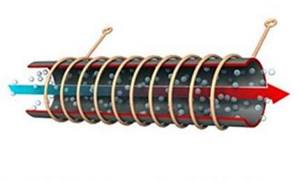
An induction coil heats the metal (pipe or pieces of wire) placed inside it using high frequency eddy currents, no contact required
Constant contact with water minimizes the likelihood of the heater burning out, which is a fairly common problem for traditional boilers with heating elements. Despite the vibration, the boiler operates extremely quietly; additional sound insulation at the installation site is not required.
Another good thing about induction boilers is that they almost never leak, unless the system is installed correctly. This is a very valuable quality for electric heating, as it eliminates or significantly reduces the likelihood of dangerous situations occurring.
The absence of leaks is due to the non-contact method of transferring thermal energy to the heater. Using the technology described above, the coolant can be heated almost to a vapor state.
This provides sufficient thermal convection to encourage efficient movement of coolant through the pipes. In most cases, the heating system will not have to be equipped with a circulation pump, although it all depends on the features and design of the specific heating system.
Sometimes a circulation pump is necessary. Installing the device is relatively easy. Although this will require some skills in installing electrical appliances and heating pipes. But this convenient and reliable device has a number of disadvantages that should also be taken into account.
For example, a boiler heats not only the coolant, but also the entire working space surrounding it. It is necessary to allocate a separate room for such a unit and remove all foreign objects from it. For a person, staying in close proximity to a working boiler for a long time can also be unsafe.

Induction heaters require electric current to operate. Both homemade and factory-made equipment are connected to a household AC network
The device requires electricity to operate. In areas where there is no free access to this benefit of civilization, an induction boiler will be useless. And even where there are frequent power outages, it will demonstrate low efficiency
An explosion may occur if the device is handled carelessly
If you overheat the coolant, it will turn into steam. As a result, the pressure in the system will increase sharply, which the pipes simply cannot withstand and will burst. Therefore, for normal operation of the system, the device should be equipped with at least a pressure gauge, and even better - an emergency shutdown device, a thermostat, etc.
All this can significantly increase the cost of a homemade induction boiler. Although the device is considered virtually silent, this is not always the case. Some models may still produce some noise for various reasons. For a device made independently, the likelihood of such an outcome increases.
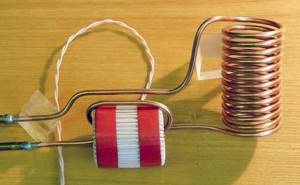
There are practically no wearing components in the design of both factory-made and home-made induction heaters. They last a long time and work flawlessly
Disadvantages of VIN heaters
- The most unpleasant drawback is the high cost;
- The need for constant power supply;
- Increased complexity of equipment (subjective).
Note : The most famous vortex induction heaters from Galant. There are many options on the Internet on how to make your own VIN heater.
©Obotoplenii.ru
Other articles in the section: Eco-friendly fuel
- Biofireplace for apartments and houses
- Types of firewood
- Types of heat pumps for home heating
- Vortex induction heaters
- Woody biomass: what is it, why is it needed?
- Liquid biofuels of the first and second generation
- Infrared heating of a private house: principle of operation, advantages, disadvantages
- Solar batteries: features of solar panels
- Heat pump: description, device, types of heat pumps
- Fuel briquettes and pellets will change your idea of home heating
Pump installation
Now you will need to select a water pump. Now in specialized stores you can purchase a unit of any modification and power.
What should you pay attention to?
- The pump must be centrifugal.
- Your engine will be able to spin it.
Install a pump on the frame; if you need to make more cross members, make them either from a corner or from strip iron of the same thickness as the corner. It is hardly possible to make a coupling without a lathe. Therefore, you will have to order it somewhere.
Diagram of a hydraulic vortex heat generator.
Potapov's vortex heat generator consists of a housing made in the form of a closed cylinder. At its ends there must be through holes and pipes for connection to the heating system. The secret of the design is inside the cylinder. There should be a nozzle behind the inlet hole. Its hole is selected individually for a given device, but it is desirable that it be half the size of a quarter of the diameter of the pipe body. If you do less, the pump will not be able to pass water through this hole and will begin to heat up. In addition, internal parts will begin to rapidly deteriorate due to the phenomenon of cavitation.
Tools: angle grinder or hacksaw, welding machine, electric drill, adjustable wrench.
Materials: thick metal pipe, electrodes, drills, 2 threaded pipes, couplings.
- Cut a piece of thick pipe with a diameter of 100 mm and a length of 500-600 mm. Make an external groove on it approximately 20-25 mm and half the thickness of the pipe. Cut the thread.
- Make two rings 50 mm long from the same pipe diameter. Cut an internal thread on one side of each half ring.
- Make covers from the same thickness of flat metal as the pipe and weld them on the unthreaded side of the rings.
- Make a central hole in the covers: one with the diameter of the nozzle, and the other with the diameter of the pipe. Make a chamfer on the inside of the cover, where the jet is located, with a larger diameter drill. The result should be a nozzle.
- Connect the heat generator to the system. Connect the pipe where the nozzle is located to the pump into the hole from which water is supplied under pressure. Connect the heating system input to the second pipe. Connect the outlet from the system to the pump inlet.
Water under the pressure created by the pump will pass through the nozzle of the vortex heat generator, which you make yourself. In the chamber it will begin to heat up due to intense stirring. Then feed it into the heating system. To regulate the temperature, install a ball locking device behind the nozzle. Cover it, and the vortex heat generator will circulate water inside the housing longer, which means the temperature in it will begin to rise. This is roughly how this heater works.
Vortex heat generator: device, operating principle, selection criteria
Not all industrial facilities have the opportunity to heat rooms with classic heat generators powered by combustion of gas, liquid or solid fuel, and the use of a heater with heating elements is impractical or unsafe. In such situations, a vortex heat generator comes to the rescue, using cavitation processes to heat the working fluid. The basic principles of operation of these devices were discovered back in the 30s of the last century and have been actively developed since the 50s. But the introduction of liquid heating into the production process due to vortex effects occurred only in the 90s, when the issue of saving energy resources became most acute.
Disadvantages of induction models
There are no ideal technical solutions yet. Even the most advanced equipment has its drawbacks, and an induction heating boiler is no exception.
It is characterized by:
- high price;
- heavy weight;
- noise.
In the manufacture of induction boilers, expensive materials are used, including ferromagnets that react to a magnetic field.
In order for the boiler to perform its function, engineers must accurately calculate the diameter of the coil wire, the number of its turns, the size of the core and other parameters. Then all these calculations must be implemented in the finished product.
Thus, the production of induction devices is a labor-intensive and metal-intensive process, which leads to high production costs. At the same time, this drawback is offset by a long service life and minimal operating costs.
The compact dimensions of the boiler are combined with its significant weight, which is explained by the large number of steel parts. Some models weigh 40 kg. The induction boiler produces little noise during operation, but this drawback is easily eliminated by using noise-absorbing gaskets, which are recommended to be installed during installation.
Active heat generators
Heating of the liquid in such vortex heat generators is carried out due to the operation of an active moving element that interacts with the coolant. They are equipped with cavitation-type chambers with disk or drum activators. These are rotary heat generators, one of the most famous among them is the Potapov heat generator. The simplest diagram of an active heat generator is shown in the figure below.
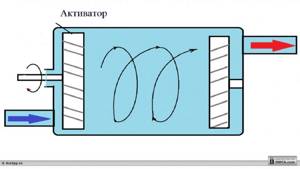
Rice. 3. schematic diagram of an active heat generator
When the activator rotates in such a cavitation heat generator, bubbles form due to holes on the surface of the activator and opposite holes on the opposite wall of the chamber. This design is considered the most effective, but also quite difficult in selecting the geometric parameters of the elements. Therefore, the vast majority of vortex heat generators have perforation only on the activator.
Types of induction boilers
There are the following types of induction heating boilers, designated both by the principle of operation and by the manufacturer’s brand:
- SAV is a type and at the same time a trademark of new generation boilers with a power from 2.5 to 100 kW, produced by the Russian company since 2007;
- VIN - the abbreviation is not only an abbreviation for the name of a type of induction device (vortex induction heaters), but also a patented name for boilers produced by Izhevsk.
Induction heaters SAV
Operation of SAV units does not require the use of an inverter; a current of 50 Hz is supplied to the inductor. The electromagnetic field induced by the primary winding causes the formation of vortex flows in the secondary winding, the role of which in boilers of this type is played by a section of a closed circuit of pipes with coolant. This section of the pipe - the secondary winding - is intensively heated under the influence of Foucault currents and transfers heat to the coolant, which is forced to circulate in the heating system using a circulation pump.

The heating system is constructed using radiators or in a labyrinthine manner, reminiscent of baseboard heating, in order to increase the total area of the outer surface (heat transfer) of the pipes - the heating circuit, at a minimum, should not be minimal in length.

SAV boilers are manufactured for voltages of 220V and 380V. They use water as a coolant (pure or with antifreeze additives), as well as antifreeze. It takes about 5-20 minutes for the unit to reach full operating power (depending on the volume of coolant), the efficiency of the heaters of such devices is at least 98%. For efficient heating of a room up to 30 square meters. An induction device with a power of 2.5 kW is sufficient, the purchase of which, complete with automation and control systems, will cost approximately 30 thousand rubles.
VIN heating units
Boilers of this type are more advanced in operating principle and design, which naturally affects their cost. To operate VIN devices, an inverter is required - a device for increasing the frequency of the incoming current. High frequency current causes the formation of an electromagnetic field of high intensity, which, in turn, causes the occurrence of more powerful eddy currents in the secondary winding. In addition, the heat exchanger and boiler body are made of ferromagnetic alloys that have their own magnetic field. The result of all these processes is a high heating intensity of the heat exchanger and, naturally, the coolant.
A VIN unit with a power of 3 kW is enough to heat a room with an area of 35-40 square meters. (depending on climatic conditions and the quality of thermal insulation of external building structures).
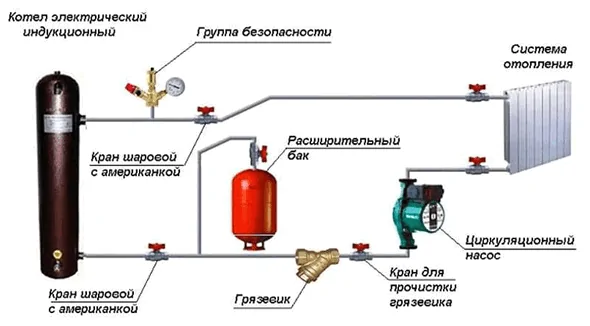
Due to their greater productivity, VIN units can be used not only in residential heating systems, but also for hot water supply. To do this, additional storage tanks equipped with automatic protection are installed into the coolant circuit, the capacity of which is calculated depending on the number of hot water intake points. These containers are provided with hot water by circulating it in a system with direct-flow heating by an induction heater.
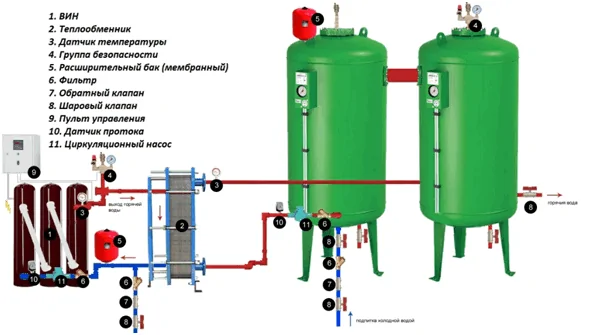
Security measures
Compliance with important rules and recommendations will help you avoid mistakes associated with the operation of inductor devices.
- Open sections of current conductors must be insulated.
- Induction heating devices are placed at a distance of 80 cm from the ceiling or floor, 30 cm from walls and furniture.
- Safe operation of the device will be ensured by installing a pressure gauge, an automatic control panel and air release.
And most importantly! Whether it’s an induction furnace made from a welding inverter or an electromagnetic boiler, responsibility for possible consequences rests with the manufacturer of the homemade device.
Anyone can assemble vortex induction heaters if they take into account all the nuances!
Advantages of induction heating boilers
Induction boilers have many absolute and comparative advantages, including the following:
- the highest efficiency among all electric boilers;
- constancy of energy characteristics;
- minimum coolant requirements;
- increased reliability;
- record long service life;
- ability to work autonomously;
- simple installation without ventilation system;
- automatic control system;
- there is no need for fuel delivery and storage:
- heating the coolant to 95 degrees;
- high level of security.
The device converts electrical energy into thermal energy with an efficiency of 98-99%. It takes 7-10 minutes to heat the coolant. A simple design in which there are no moving mechanical parts, steel alloys used as manufacturing materials make induction boilers record-breakingly durable.
Such equipment can only be damaged by damage to the electrical insulation. But as the practice of operating transformers, which in their design are in many ways similar to induction boilers, shows, they can really last for many decades.
According to manufacturers, units operating due to the effect of electromagnetic induction provide uninterrupted heating of rooms for 100 thousand hours, that is, 30 heating seasons. At the same time, their power does not decrease over time, which cannot be said about electrode and conventional heating element boilers.
Induction boilers can be used both as main and additional equipment. For example, preparing coolant for an irregularly used underfloor heating system
The same reasons that determine the durability and increased reliability of induction heaters also reduce operating costs. The induction boiler does not require regular maintenance and repair, which saves money.
Compared to many other fuels, using electricity to heat homes remains the most cost-effective. This is especially true for non-gasified settlements.
The design of the certified induction boiler prevents short circuits. Manufacturers claim that any model has the highest electrical safety class. An induction boiler should not be confused with a microwave oven, since it uses a different frequency of electric current to operate.
Heating of the coolant in an induction boiler occurs evenly - the temperature difference in the system is no more than 30°C. That is, there are no local overheats that could lead to fire, which makes such units fireproof.
Thanks to the magnetization of the coolant, fine vibration, invisible to others, and turbulent turbulence, virtually no mineral deposits form in induction boilers, which has a beneficial effect on efficiency. Let us remember that a thick layer of scale slows down the speed and efficiency of heating the coolant.
To increase power, it can use a cascade of three or more induction boilers with a common control cabinet. This solution will help heat a two-story mansion
If you follow the operating rules specified in the instructions, then after installation and setting the temperature regime you will not have to think about the boiler throughout the entire heating season. Unlike solid fuel “brothers”, induction devices do not require regular loading of firewood and coal and removal of ash. No pipe cleaning is required, which distinguishes them from other types of electric boilers.
The boiler itself and its additional equipment take up little space and can be installed in a small room. The control system components allow the use of induction boilers in conjunction with other climate control equipment.
Induction boilers can be integrated into an intelligent home equipment control system called “Smart Home”
Advantages of vortex induction heaters
- VIN heaters have a very high efficiency - 99%;
- No scale during VIN operation;
- High fire safety;
- High electrical safety;
- Possibility of using various coolants (antifreeze, oil, water);
- There is no need for preventive off-season maintenance of equipment;
- Unpretentious and convenient operation;
- Easy installation;
- Environmental safety (no harmful emissions);
- Long service life - 25 years.
